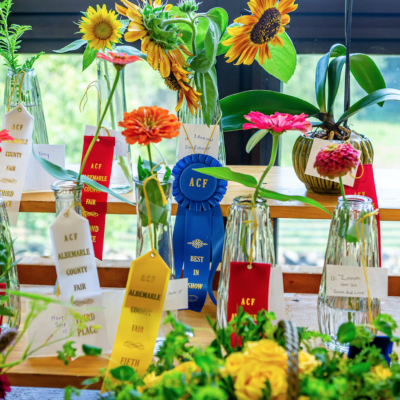Weather Alert: stretches of balmy temperatures followed by frigid cold. A typical Virginia winter, really. But there’s a whiff of fear in the air these days. Few doubt the climate is warming and weather is becoming more extreme, but is this winter just another blip on the ancient screen of global history or does it foretell catastrophe?
Most gardeners I’ve talked to aren’t changing their schedules for February. “As soon as the ground can be worked” is always the right time to plant early crops. When the soil crumbles in your hand like moist cake instead of rolling up into gummy little balls, it is time to turn from geopolitical concerns and get some seeds in the ground.
 |
Spinach, mustard, kale and mache take colder temperatures than the lettuces and are good for the earliest harvests. Some gardeners with warm microclimates (think of a stone wall behind a south-facing bed) even sow lettuce toward the end of the month if the soil feels right. Check out the colorful seed catalogs littering the mail and cruise the aisles of the local hardware stores and garden centers to get an idea of the different possibilities.
You can make it as complicated (cold frames, frost cloth, hotbeds lined with manure) or as simple as you want. Eliot Coleman’s Four Season Harvest (Chelsea Green, 1999) has the best season-extending techniques. I prefer the stripped down approach: a little patch of well-drained earth with full or half day sun, a couple of inches of well-rotted compost, straw or pine tags for mulch. Turn over the soil, break up the clumps. Remove any stones and roots and rake smooth.
Sow tightly in blocks rather than rows to keep weeds down and take advantage of small spaces. As individual plants grow, harvest the thinnings. As they grow larger, harvest lower leaves on some and let others develop into full-sized plants. Growing your own avoids the pitfalls of industrial agriculture (internal combustion engines transporting E. coli-laced spinach) while achieving the gourmand’s Holy Grail, the season’s freshest.
There’s another green many believe indispensable to the good life. For some, the best lawn is none at all. But there are ways to enjoy a bit of turf about the place without adding run-off nutrients to the dead zones in the Bay. Here’s a ground rule: All the fertilizer in the world (and for some, alas, that does seem to be the preferred dosage) will do the greensward no good if the soil’s relative acidity (the pH) is not right.
Quality turf is a harsh mistress and demands a pH between 6.2 and 6.5. With acidic clay, only regular doses of lime will do. Test every few years to find out how much to apply. Call the local Virginia Cooperative Extension Office (872-4580) for info on having samples tested, or use a garden center. You can test pH with a handy home kit, but the key is how much lime to apply and a professional test will tell you that.
As we ponder the difference between weather and climate, between the delights of early greens and polar bears treading water, let us take heart and turn to the tasks at hand: Begin to learn your soil; dig and tread carefully upon the Earth; plant some seeds if you can.




